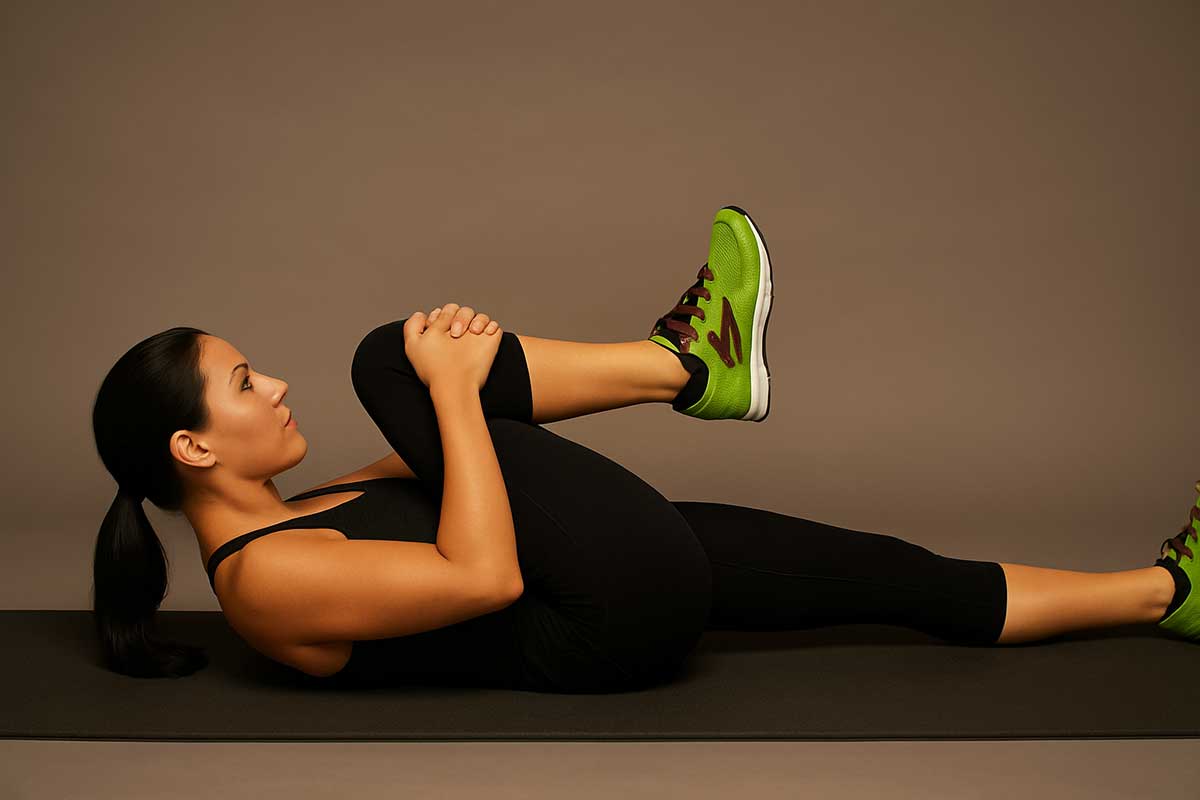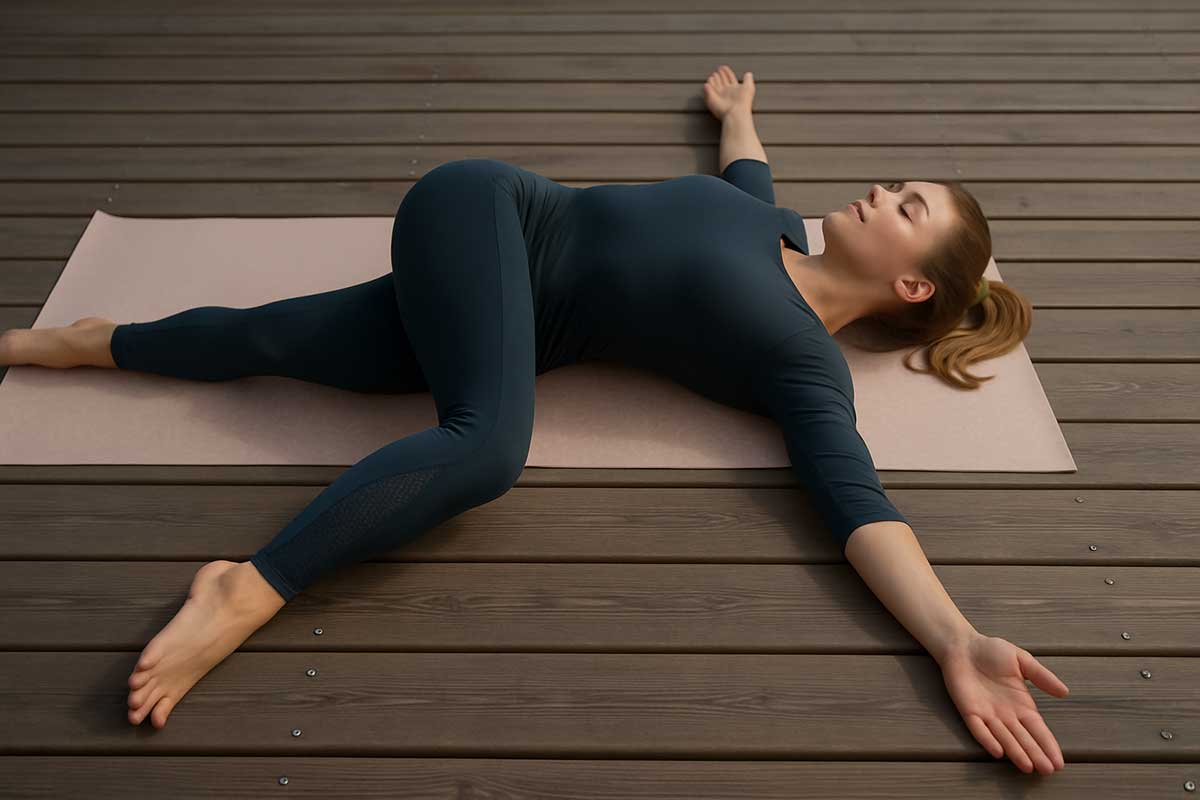Struggling with morning back pain? This 5-move routine takes under 5 minutes and targets the root causes: overnight stiffness, poor circulation, and weak core activation. Most people see improvement within a week. Do these moves in bed and on the floor each morning, plus follow our sleep and hydration tips for best results.
Over 80% of people deal with back pain at some point
But morning back pain is especially frustrating because it starts your day on the wrong foot.
Here’s what happens while you sleep. Your spine stays in one position for hours. Blood flow slows down. Your muscles get stiff. The discs between your vertebrae actually soak up fluid overnight, making them plumper and putting more pressure on nearby nerves.
Think of it like this: your spine is like a car that’s been sitting in the garage all winter. It needs a gentle warm-up before you can drive it properly.
The good news is that you can change how your mornings feel. This isn’t about complex treatments or expensive equipment. It’s about five simple moves that take less time than brewing your coffee. Many people notice a real difference within a week of doing this routine consistently.
Quick assessment: is morning back pain your problem?
Before we jump into the routine, take this quick self-check:
- Does your back hurt most when you first get out of bed?
- Does the pain ease up after 30-60 minutes of being awake?
- Is the pain worse after sleeping in a different bed?
- Do you feel stiff and need to “work out the kinks” each morning?
If you answered yes to most of these, you’re dealing with mechanical morning back pain—exactly what this routine targets. If your pain is severe, radiates down your legs, or comes with numbness, see a healthcare provider first.
Your 5-move morning routine for a pain-free back
These moves are designed to wake up your spine gently and prepare it for the day ahead. Do them in order, right after you wake up. You can even do the first few while still in bed.
Your complete morning routine at a glance:
| Move | Duration | Location | Main Benefit | Difficulty |
|---|---|---|---|---|
| Knee-to-Chest Stretch | 1-2 minutes | In bed | Relieves muscle stiffness | Easy |
| Supine Twist | 1 minute | In bed | Restores spinal mobility | Easy |
| Pelvic Tilt | 1 minute | In bed | Activates core support | Easy |
| Cat-Cow Stretch | 1-2 minutes | Floor/firm surface | Improves circulation | Easy-Medium |
| Log Roll Exit | 30 seconds | Bed to standing | Prevents disc compression | Easy |
Total Time: 4.5-6.5 minutes
Move 1: The gentle wake-up (knee-to-chest stretch)

How to do it: Stay lying on your back. Slowly pull one knee toward your chest. Use both hands to hold it there for 20-30 seconds. Feel the gentle stretch in your lower back. Switch legs and repeat. Do this 2-3 times on each side.
Why it works: This move targets your erector spinae muscles—the long muscles that run along your spine. It also stretches your glutes, which often get tight overnight and pull on your lower back. You’re basically telling these muscles, “Hey, it’s time to wake up and get moving.”
Common mistakes to avoid:
- Don’t yank or force your knee toward your chest
- Keep your other leg relaxed on the bed
- Breathe normally—don’t hold your breath
Move 2: The spine aligner (supine twist)

How to do it: Keep lying on your back with knees bent and feet flat on the bed. Let both knees fall gently to one side while keeping your shoulders flat. You should feel a nice stretch along your spine and hip. Hold for 20-30 seconds, then slowly bring your knees back to center and repeat on the other side.
Why it works: Your spine has been locked in one position all night. This gentle twist increases mobility in your vertebrae and stretches your hip muscles. Tight hips are often the hidden cause of lower back pain because they change how your pelvis sits.
Modification for sensitive backs: If this feels too intense, place a pillow between your knees when they drop to the side.
Move 3: The core activator (pelvic tilt)

How to do it: Still on your back with knees bent and feet flat. Place your arms by your sides. Now, gently press your lower back into the bed by tightening your stomach muscles and tilting your pelvis up slightly. Hold for 10 seconds. Relax and repeat 5 times.
Why it works: This isn’t just a stretch—it’s activation. You’re waking up your deep core muscles, specifically your transverse abdominis. These muscles act like a natural back brace. When they’re strong and active, they take pressure off your spine throughout the day.
Move 4: The all-in-one mobilizer (cat-cow stretch)

How to do it: Time to get out of bed for this one. Get on your hands and knees on the floor (or on a firm mattress). Slowly arch your back toward the ceiling like an angry cat, tucking your chin to your chest. Hold for 5 seconds. Then reverse it—let your belly sink toward the floor as you lift your head and look up, like a cow. Hold for 5 seconds. Repeat this flowing movement 5-10 times.
Why it works: This dynamic movement is like oil for a rusty hinge. It promotes blood flow to the discs in your spine and improves flexibility along your entire back. The pumping action also helps squeeze out inflammatory fluids that may have built up overnight.
Progression tip: As you get comfortable with this move, you can add gentle side-to-side movements while in the “cow” position to mobilize your spine in multiple directions.
Move 5: The safe stand-up (the log roll)
How to do it: Here’s how to get out of bed safely. Don’t sit straight up like you see in movies. Instead, roll onto your side first. Use your arms to push yourself up into a seated position while letting your legs swing off the side of the bed. Then stand up slowly.
Why it works: When you bolt upright from lying down, you create sudden pressure on your spinal discs—sometimes up to 300% more pressure than when lying flat. The log roll technique keeps your spine in a neutral position and prevents that jarring compression that can trigger pain.
Alternative exercises for limited mobility
Can’t get on the floor? Have knee problems? Here are bed-friendly alternatives:
| Original Exercise | Alternative | Instructions |
|---|---|---|
| Cat-Cow Stretch | Seated Spinal Wave | Sit on edge of bed, slowly arch and round your back |
| Floor movements | Bed-based twists | Do all movements on a firm mattress |
| Standing positions | Supported stretches | Use bed or wall for balance |
Supercharge your results: key habits that make the difference
Doing these five moves consistently will make a huge difference. But if you want to maximize your results, pay attention to these habits that can either help or hurt your progress.
Your sleep position matters
Not all sleep positions are created equal when it comes to your back health.
| Position | Back Pain Risk | Pros | Cons | How to Improve It |
|---|---|---|---|---|
| Back sleeping | Low | Neutral spine alignment | May worsen sleep apnea | Add pillow under knees |
| Side sleeping | Low-Medium | Good for breathing | Hip misalignment possible | Pillow between knees, supportive head pillow |
| Stomach sleeping | High | May reduce snoring | Neck strain, back arch | Thin pillow under hips, train to sleep on side |
Best positions:
- On your back with a pillow under your knees (keeps your spine neutral)
- On your side with a pillow between your knees (prevents your top leg from pulling on your spine)
Worst position:
- On your stomach (forces your neck to turn and can arch your lower back too much)
If you’re a stomach sleeper, try putting a thin pillow under your hips to reduce the arch in your back. Better yet, gradually train yourself to sleep on your side by using a body pillow for support.
Is your mattress the culprit?
Your mattress might be sabotaging your progress. Here’s your complete evaluation guide:
| Warning Sign | What It Means | Urgency Level | Action Needed |
|---|---|---|---|
| Age 7-10+ years | Natural wear and lost support | Medium | Start shopping for replacement |
| Visible sagging/indentations | Structural breakdown | High | Replace immediately |
| Sleep better elsewhere | Your mattress isn’t supporting you | High | Time for a new one |
| Wake up stiffer than bedtime | Poor spinal alignment | Medium | Evaluate firmness level |
| Partner disturbance | Motion transfer issues | Low | Consider motion-isolating mattress |
| Body impressions remain | Lost structural integrity | High | Replace soon |
The Goldilocks principle: Your mattress should be firm enough to support your spine’s natural curves but soft enough to contour to your body. Medium-firm mattresses work best for most people with back pain.
Quick test: If you can see or feel a body impression that doesn’t bounce back after you get up, your mattress has lost its support.
Daily hydration and movement protocol
Your spinal discs are mostly water—about 80% when you’re young. As you age, they lose some of that water content, but staying hydrated still matters.
Morning hydration boost recipe:
- 16-20 oz of water within 30 minutes of waking
- Add a pinch of sea salt and lemon if you like (helps with absorption)
- Wait 30 minutes before coffee (caffeine can interfere with hydration)
Workday movement breaks (every 30-60 minutes):
| Time | Activity | Duration | Benefit |
|---|---|---|---|
| Every 30 min | Stand and walk | 2-3 minutes | Prevents stiffness |
| Every hour | Shoulder rolls | 10 reps | Releases upper tension |
| Every 2 hours | Gentle neck stretches | 30 seconds each direction | Prevents neck pain |
| Every 2 hours | Hip circles | 5 each direction | Keeps hips mobile |
Evening wind-down protocol:
- Light stretching or gentle yoga (10-15 minutes)
- Avoid screens 1 hour before bed (blue light disrupts sleep quality)
- Keep bedroom cool (65-68°F) for better sleep
- Use blackout curtains or eye mask
Equipment-free office stretches
Stuck at a desk all day? These moves prevent your back from getting stiff again:
| Stretch | How To Do It | Hold Time | Frequency |
|---|---|---|---|
| Seated Spinal Twist | Sit tall, rotate torso left/right | 15-20 seconds | Every hour |
| Seated Figure-4 | Ankle on opposite knee, lean forward | 20-30 seconds | 2x per day |
| Standing Back Extension | Hands on lower back, gentle arch | 10 seconds | After long sitting |
| Wall Push-Up | Hands on wall, lean in and out | 10 reps | Mid-morning/afternoon |
| Neck Rolls | Gentle circles, both directions | 5 each way | Every 30 minutes |
Troubleshooting common issues
What if the routine makes my pain worse?
Stop immediately and consult a healthcare provider. Some back pain needs professional evaluation, especially if it’s severe, radiates into your legs, or comes with numbness or tingling.
What if I don’t feel better after a week?
- Double-check your form—gentle is key
- Ensure you’re doing the moves in the right order
- Consider whether other factors (stress, poor sleep, sedentary lifestyle) might be contributing
- If pain persists, see a physical therapist or doctor
I’m too stiff to do some moves. What now?
Start with what you can do. Even the knee-to-chest stretch alone can help. Modify movements to your comfort level and gradually increase range of motion as you get more flexible.
Should I do this routine if I have disc problems?
Check with your doctor first. Most gentle movements are safe, but herniated discs or severe degeneration may need specific modifications.
Your 7-day success timeline
Days 1-2:
You might feel slightly more mobile, but don’t expect miracles yet. Focus on learning the moves correctly. Some people feel immediate relief, others need more time.
Days 3-4:
Many people start noticing they can get out of bed with less stiffness. Your muscles are beginning to adapt to the new routine. Keep going!
Days 5-7:
This is when the real changes often happen. Your body is adapting, circulation improves, and the routine becomes easier. You might notice less morning stiffness overall.
Week 2 and beyond:
Continue the routine to maintain your progress. Consider adding other activities like walking, swimming, or yoga classes.
Week 2+ progression exercises
Ready to take it up a notch? Add these moves after mastering the basic routine:
| Exercise | Description | Reps/Duration | Benefits |
|---|---|---|---|
| Bridge Hold | Lift hips while lying on back | 15-30 seconds | Strengthens glutes and core |
| Dead Bug | Opposite arm/leg extensions lying down | 5-10 each side | Core stability |
| Bird Dog | Opposite arm/leg on hands and knees | Hold 10 seconds | Full spine stability |
| Wall Sit | Back against wall, knees bent | 15-30 seconds | Leg and core strength |
Sleep hygiene checklist
Quality sleep supports back health. Check off what you’re doing right:
Bedroom environment:
Pre-sleep routine:
Sleep position setup:
When to see a doctor – warning signs
| Symptom | Urgency Level | Action |
|---|---|---|
| Severe pain that doesn’t improve | High | See doctor within 1-2 days |
| Pain radiating down legs | High | Medical evaluation needed |
| Numbness or tingling in legs/feet | Very High | Same-day medical attention |
| Loss of bladder/bowel control | Emergency | Go to ER immediately |
| Fever with back pain | High | See doctor same day |
| Pain after injury/fall | High | Medical evaluation needed |
| Progressive weakness in legs | Very High | Urgent medical care |
Conclusion
These five moves are your toolkit for pain-free mornings. The knee-to-chest stretch wakes up your muscles. The spinal twist restores mobility. The pelvic tilt activates your core. The cat-cow promotes circulation. And the log roll protects your spine when you get up.
Five minutes. That’s all it takes. Less time than you spend scrolling through your phone or waiting for your coffee to brew.
Consistency is your secret weapon here. You might feel some relief after the first day, but the real magic happens when you make this routine as automatic as brushing your teeth. Within a week, many people notice they’re not starting their day with that familiar ache.
Your back has been sending you a message every morning. Now you know how to listen—and how to respond. Take back control of your mornings, one gentle stretch at a time.
Key takeaways
- Morning back pain affects over 80% of people at some point
- A 5-minute routine can make a significant difference within 7 days
- Sleep position and mattress quality play huge roles in back health
- Gentle, consistent movement beats aggressive stretching
- Track your progress to stay motivated
- Know when to seek professional help
Remember: This routine works for mechanical morning back pain—the kind caused by stiffness and poor sleep positioning. If your pain is severe, persistent, or comes with other symptoms like leg numbness, fever, or bladder issues, see a healthcare provider right away. Your spine health is worth a professional evaluation when something doesn’t feel right.
This information is for educational purposes and doesn’t replace professional medical advice. Always consult healthcare providers for persistent or severe back pain.
FAQs
Why does my lower back hurt when I wake up?
Morning back pain usually happens because your spine has been in one position for 6-8 hours. Muscles get stiff, circulation slows, and spinal discs rehydrate overnight, which can increase pressure on nerves.
Are these stretches safe for herniated discs?
While gentle movements are often helpful, anyone with diagnosed disc problems should check with their doctor or physical therapist before starting any new routine.
How long should I do this routine?
Think of it like brushing your teeth—it’s a daily habit for maintaining back health. Many people continue indefinitely because it prevents problems from returning.
Can I do these moves if I’m pregnant?
Most of these stretches are safe during pregnancy, but check with your doctor first. You may need to modify positions as your pregnancy progresses.
What if I travel frequently?
All these moves can be done in hotel rooms. The routine is designed to be portable—no equipment needed.
Best stretches for morning back pain?
The five moves in this routine specifically target morning stiffness: knee-to-chest, spinal twists, pelvic tilts, cat-cow stretches, and proper bed exit technique.


